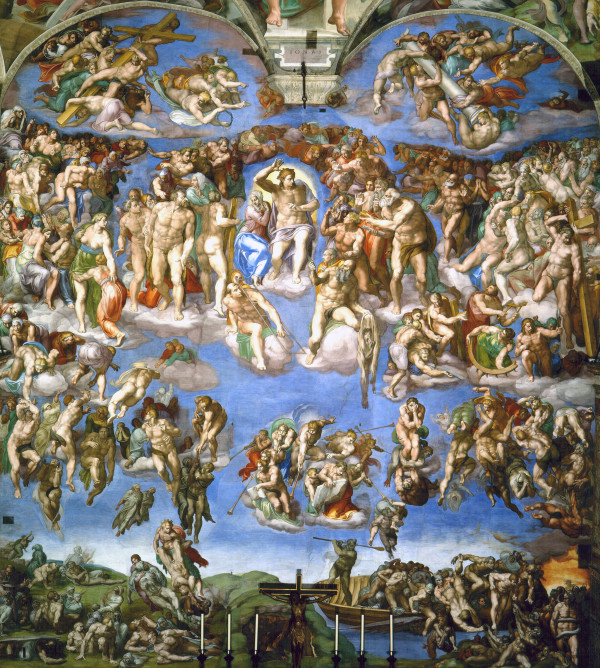
(Note: all bibliographic information, including the works cited page, has been removed from this essay)
In the year of 1565, just one year after Michelangelo’s death, a pupil of the famous artist added loin cloths to censor the exposed figures in his famous Sistine Chapel painting The Last Judgement. This pupil was later ridiculed with the unfortunate title of “Braghettone,” meaning “the britches-maker,” but he was hardly unique. Pope Daniele de Volterra, the Pope during the time of Michelangelo’s life, was the individual who ordered for the “Braghettone” to clothe the Sistine Chapel figures. Moreover, Biagio Cardinal da Cesena criticized Michelangelo’s work, describing it as “a stew of nudes, better suited to a bathhouse or roadside wine shop than the Pope’s chapel.” Seemingly sinless to modern eyes, the nudity in this work of art provoked many negative feelings in people and popes of that time period. Michelangelo’s fresco was “deemed unholy and immoral by many proponents of the Catholic faith.” Though nudity in visual art has been prominent in many cultures throughout the history of the Western world, artists’ work has often been censored because of it, causing artists to defend and protect their rights by speaking out about censorship or protesting by taking their censored artwork down from display.
More examples of the censorship of visual art can be seen further ahead in history. In the 19th century, a very well known instance of censorship occurred with Gustave Courbet’s oil painting L’Origine du Monde. The piece was “Originally part of a collection dedicated to the female figure.” Because of its glaring nudity, the painting was very controversial and was not exhibited publicly until 1995, over 100 years after its creation, when it became a part of the collection at the French Musée d’Orsay. An even more recent case of censorship occurred in the early days of 2015, when a bronze statue by Frederick W. MacMonnies entitled Bacchante and Infant Faun was installed in the courtyard of the Boston Public Library. The 19th century statue depicts a nude Roman wine deity holding a child. Many modern-day people would consider the statute to be somewhat tasteful, one being Huffington post editor Priscilla Frank, who says that it “doesn’t look all that NSFW [Not Safe for Work].” Members of the The Women’s Christian Temperance Union, however, disagree. They described the statue as “drunken indecency” on display. Upon its installation, the piece “sparked outrage” and was eventually moved to the Metropolitan Museum of Art in New York.
The most controversial pieces of artwork are the ones most susceptible to censorship. When an artist has a creative vision, he or she will often take action to defend the work from censorship. “I believe that the base of any culturally free city depends on its acceptance of the body nude, in art and in life,” wrote photographer Spencer Tunick, whose 1990’s mass nude photo shoots sparked debate. People like Spencer Tunick defending nudity in art often use a clause in the state statute that allows nudity with the public breastfeeding of infants and in performances as an argument. Another more recent artist, 74 year old Danuta Gray, fought censorship by taking her artwork containing nudity off display in 2013 when it was censored by its exhibiting gallery, which used strips of paper to cover the subject’s genitalia. The censorship was prompted by a complaint from a school teacher after a class trip. Gray was infuriated, stating “There is nothing as beautiful as the naked body,” and “I don’t want to be part of it. I am disgusted. How dare they accept pictures and then censor them?” The Birmingham Botanical Gardens, which exhibited Gray’s art, responded by saying “We do our very best at all times to ensure everyone has an enjoyable time whilst they are on site. Sometimes we have to adapt spaces for use by different sectors of our audiences at different times.” Brian Reed, a New York City artist, suffered a case of near censorship. His 2010 piece, featuring a live naked woman standing in the street window of Chair and The Maiden gallery, sparked some controversy about the public rights that citizens have. Reed made the artistic choice for a reason, stating that the model, who stood “fully naked under a suspended web made of various objects including shark eggs and teeth, beads and clay pipes” was naked so that “she can be fully at the center of that connectivity of energy.” The installation attracted many different kinds of attention from people, and led Daniel S. Connolly, a New York law firm partner, to state “If you’re walking down a street in New York City and someone is naked in the window — and so children and whoever can see it — you’re depriving people of their choice. That’s where you butt up against other people’s rights.” This lawyer, along with some members of law enforcement, were in favor of shutting down the installation because of their belief that the first amendment did not necessarily protect the right to public nudity. Brian Reed defended his piece, saying, “I believe that the base of any culturally free city depends on its acceptance of the body nude, in art and in life.” In the end, the model featured in the piece made it through her four-hour shift in the window that day, but not without sparking some controversy first.
The censorship of nudity in art often occurs for reasons like the aforementioned, but other times, nudity is censored for religious reasons. A case of this type of censorship occurred in 2013 when an adult education center in Berlin removed six nude paintings from their hallways. This action sparked a debate about “the difference between art and pornography as well as the importance of artistic freedom versus religious sensitivity.” The paintings were removed by the school’s deputy, who was fearful that the works might shock Muslim students and stop them from attending classes. Sean Roberts, Assistant Professor of Art History at U.S.C, explains that most Muslim students are not offended by nudity and censorship, in this case, the censorship was therefore unnecessary. Roberts also discusses the display of nude art in a public space versus in a museum or “artistic sanctuary.” “There is a distinction to be made between works on display within museum and gallery spaces and those placed prominently in the public areas of a building like a school.” He believes that some artworks that are appropriate in a museum would not be considered appropriate for display in a public location, which most people understand. And censorship, in this case, did not occur in a museum, so officials could argue that the best interest of the public was taken into account.
The digital world also suffers instances of nude art censorship; Facebook and YouTube being the biggest culprits. Facebook’s “no nudity” policy is the justification for the removal of images that contain “even the slightest hint of nudity.” Sometimes it is artists’ work that is censored, but sometimes general users’ posts are censored. One artist, Michael Colanero, posted a Body Painting project for Breast cancer awareness, and it was declared “pornography” and removed. One general user, Frode Steinicke, uploaded an image of Gustave Courbet’s The Origin of the World and it was removed by Facebook. YouTube also has a policy against nudity, and was responsible for the removal of a one-minute video entitled “The Last War Crime.” According to YouTube, the video contained “nudity, pornography, or other sexually provocative content.” In this case, viewers retaliated, and YouTube re-uploaded the video after receiving over 7,000 messages in protest of the censorship of the video.
Since the 16th century, nudity in art has been censored. Whether it be in a public school, a museum, or even online, visual art has suffered from censorship for more than four centuries. Artists’ creative ideas have been obscured and disrespected, and their rights as artists have been infringed. Or have they been? There is debate about this, and about whether or not the First Amendment protects nudity in art. Regardless, artists often defend their work against censorship. Contrary to the rights of artists being stepped on, the rights of the general public have actually been protected with the censorship of nudity in art in some cases. The removal of art containing nudity from public places allows people the right to choose whether or not they want to view the nudity. The issue has been disputed for years, and the end of censorship of nudity in visual art does not seem near. The question really comes down to what can be defined as art and what is exploitation. This being said, it seems as though the argument will continue on, just as it has for the past 400 years.
